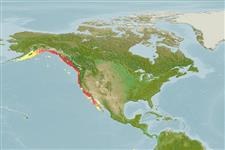Teleostei (teleosts) >
Perciformes/Zoarcoidei (Eelpouts and pricklebacks) >
Zoarcidae (Eelpouts) > Lycodinae
Etymology: Lycodes: Greek, lykos = wolf + Greek, suffix, oides = similar to (Ref. 45335); cortezianus: Named for the Cortez Bank, off San Diego, California (Ref. 4925).
Eponymy: The etymologies do not help, but we believe these species are named after the Sea of Cortez where the holotypes were caught, or in the case of the eelpout, Cortez Bank off San Diego, California. (Ref. 128868), visit book page.
More on author: Gilbert.
Environment: milieu / climate zone / depth range / distribution range
Ecology
Marine; bathydemersal; depth range 73 - 620 m (Ref. 2850). Deep-water
Eastern Pacific: Prince of Wales Island, Alaska to San Diego, California, USA.
Size / Weight / Age
Maturity: Lm ? range ? - ? cm
Max length : 50.0 cm TL male/unsexed; (Ref. 2850)
Short description
Identification keys | Morphology | Morphometrics
Dorsal spines (total): 0; Dorsal soft rays (total): 105 - 108; Anal spines: 0; Anal soft rays: 89 - 93. Caudal rounded but not clearly distinguished from dorsal and anal fins; pectorals large; pelvic fins much reduced (Ref. 6885). Brown to blue black on back and sides, lighter ventrally; white on scale pockets; dark above base of pectoral fins; black along anterior border of dorsal fin, on posterior parts of dorsal and anal fins, and on caudal; light margins on pectoral fins (Ref. 6885).
Found on muddy bottoms (Ref. 2850).
Life cycle and mating behavior
Maturity | Reproduction | Spawning | Eggs | Fecundity | Larvae
Anderson, M.E., 1994. Systematics and osteology of the Zoarcidae (Teleostei: Perciformes). Ichthyol. Bull. J.L.B. Smith Inst. Ichthyol. 60:120 p. (Ref. 11954)
IUCN Red List Status (Ref. 130435: Version 2024-1)
Threat to humans
Harmless
Human uses
Tools
Special reports
Download XML
Internet sources
Estimates based on models
Preferred temperature (Ref.
123201): 5 - 8.7, mean 6.5 °C (based on 52 cells).
Phylogenetic diversity index (Ref.
82804): PD
50 = 0.5000 [Uniqueness, from 0.5 = low to 2.0 = high].
Bayesian length-weight: a=0.00269 (0.00141 - 0.00516), b=3.22 (3.06 - 3.38), in cm total length, based on LWR estimates for this Genus-body shape (Ref.
93245).
Trophic level (Ref.
69278): 3.5 ±0.5 se; based on size and trophs of closest relatives
Resilience (Ref.
120179): Very Low, minimum population doubling time more than 14 years (Preliminary K or Fecundity.).
Fishing Vulnerability (Ref.
59153): Moderate vulnerability (40 of 100).
